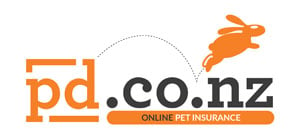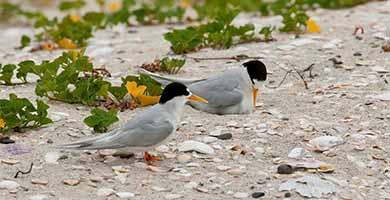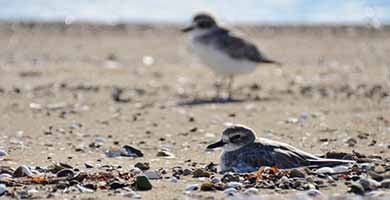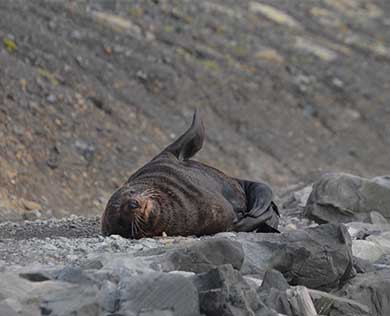Dogs on Auckland beaches
Introduction
Keep wildlife safe by knowing where to look out for them while dog walking on beaches in the Tāmaki Makaurau/Auckland region.
Lead the Way and PD Insurance NZ have joined forces to empower Auckland dog owners to become wildlife wise.
PD Insurance website
On this page:
Where to look out for wildlife
Birds, seals, and other wildlife are common on Auckland beaches. Here are four taonga species that are particularly sensitive so look out for them when out with your dog. For some of these species, they are so rare that dogs may not be allowed at some beaches. Check the rules for a beach before you go.
New Zealand fairy tern/tara iti

Tara iti often blend into their surroundings at a distance due to their colouring.
Malcolm Pullman | ©
The New Zealand fairy tern/tara iti is probably New Zealand's rarest breeding bird. Nesting in a small scrape in the sand, these delicate sea birds are very vulnerable. Nest sites are roped off and signs erected to alert people to the area.
Tara iti are so rare that they only breed in four locations all restricted to the Northland Peninsula. Two of these sites are in the Auckland region:
- Pakiri – Auckland
- Papakanui Spit – Auckland
- Waipu – Northland
- Mangawhai – Northland
New Zealand dotterel/tūturiwhatu

NZ dotterel nests are a scrape in the sand and easily damaged by people and dogs
Shellie Evans | ©
The endangered New Zealand dotterel was once widespread and common. Now there are only about 2500 birds left, making dotterels more at risk than some species of kiwi.
New Zealand dotterel nest in open sites, typically low-lying sand or gravel banks and sandbars close to beaches and lagoons. The birds often nest close to residential or developed areas. Uncontrolled dogs running through nesting areas can crush eggs, disturb nesting adults, and kill chicks.
Photos of New Zealand dotterel/tūturiwhatu and more information.
In the Auckland region, New Zealand dotterel nest at a range of beaches including:
- Pakari river mouth
- Tāwharanui
- Te Henga / Bethells Beach
- Waiheke and Great Barrier Islands
- Te Arai.
Brown teal/pāteke

Female pāteke with chicks.
DOC Crown Copyright
Pāteke are New Zealand's rarest water fowl. They have declined in numbers and range since the late nineteenth century. Pāteke were once widespread around New Zealand but due to predation, hunting, disease and habitat loss all wild populations declined and some populations went extinct.
There are currently estimated to be between 2,000 and 2,500 pāteke living in a wild state in New Zealand, making it New Zealand’s rarest waterfowl species on the mainland.
In the Auckland region pāteke are found normally on Great Barrier Island (Aotea Island). Especially around Whangapoua Estuary on Great Barrier Island (Aotea Island).
Fur seal/kekeno

Example of fur seal/kekeno likely spot on the beach
Image: Ian Banatoski | ©
Fur seals breed and haul-out (rest) on rocky coastlines sometimes in large numbers. In winter you may see them as solo adventurers on the beach and on sides of a coastal track.
They blend into their surroundings. Your dog might smell one long before you know it’s there, so keep alert.
Kekeno are recolonising much of their former range. For the Auckland region this means numbers are increasing and they may turn up in random areas. One was found in a South Auckland car wash once.
But they are also becoming more common in places like:
- Manukau Harbour
- east coast of Auckland
- Waiheke Island.
Keep a look out for kekeno and leash your dog to walk past.
Specific ways to keep wildlife safe
More ways to keep wildlife safe when with your dog on beaches.
Get a Lead the Way lead
Lead the Way leads convey visually what temperament your dog has. By using these leads while out on walks, you're also advocating for the protection of our precious wildlife.
Dogs on conservation land
Different conservation areas have different rules. Some areas allow dogs, others require a permit, and some do not allow dogs at all.
Tracks, campsites, and hunting areas you can take your dog on conservation land.

